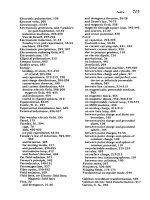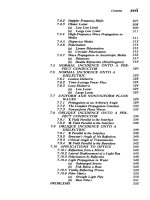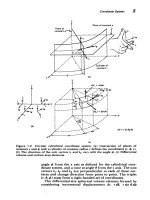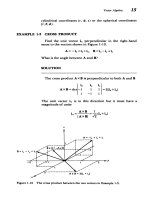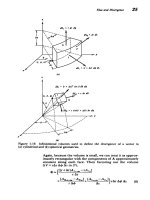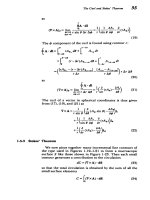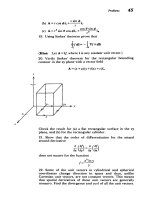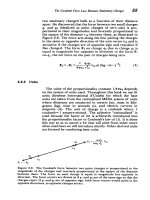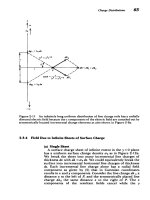Electromagnetic Field Theory: A Problem Solving Approach Part 3 pot
Bạn đang xem bản rút gọn của tài liệu. Xem và tải ngay bản đầy đủ của tài liệu tại đây (240.63 KB, 10 trang )
Contents
xvii
7.4.2
Doppler
Frequency
Shifts
507
7.4.3
Ohmic
Losses
508
(a)
Low
Loss
Limit
509
(b)
Large
Loss
Limit
5
1
7.4.4
High-Frequency
Wave
Propagation
in
Media
511
7.4.5
Dispersive
Media
512
7.4.6
Polarization
514
(a)
Linear
Polarization
515
(b)
Circular
Polarization
515
7.4.7
Wave
Propagation
in
Anisotropic
Media
516
(a)
Polarizers
517
(b)
Double
Refraction
(Birefringence)
518
7.5
NORMAL
INCIDENCE
ONTO
A
PER-
FECT
CONDUCTOR
520
7.6
NORMAL
INCIDENCE
ONTO
A
DIELECTRIC
522
7.6.1
Lossless
Dielectric
522
7.6.2
Time-Average
Power
Flow
524
7.6.3
Lossy
Dielectric
524
(a)
Low
Losses
525
(b)
Large
Losses
525
7.7
UNIFORM AND
NONUNIFORM
PLANE
WA
VES
529
7.7.1
Propagation
at
an
Arbitrary
Angle
529
7.7.2
The
Complex
Propagation
Constant
530
7.7.3
Nonuniform
Plane
Waves
532
7.8
OBLIQUE
INCIDENCE
ONTO
A
PER-
FECT
CONDUCTOR
534
7.8.1
E
Field
Parallel
to
the
Interface
534
7.8.2
H
Field
Parallel
to
the
Interface
536
7.9
OBLIQUE
INCIDENCE
ONTO
A
DIELECTRIC
538
7.9.1
E
Parallel
to
the
Interface
538
7.9.2
Brewster's
Angle
of No
Reflection
540
7.9.3
Critical
Angle
of
Transmission
541
7.9.4
H
Field
Parallel
to
the
Boundary
542
7.10
APPLICATIONS
TO OPTICS
544
7.
10.1
Reflections
from
a
Mirror
545
7.10.2
Lateral
Displacement
of
a
Light
Ray
545
7.10.3 Polarization
by
Reflection
546
7.10.4
Light
Propagation
in
Water
548
(a)
Submerged
Source
548
(b)
Fish
Below
a
Boat
548
7.10.5
Totally.
Reflecting
Prisms
549
7.10.6
Fiber
Optics
550
(a)
Straight
Light
Pipe
550
(b)
Bent
Fibers
551
PROBLEMS
552
XViii
Contents
Chapter
8 GUIDED
ELECTROMAGNETIC
WAVES
567
8.1
THE
TRANSMISSION
LINE
EQUA-
TIONS
568
8.1.1
The
Parallel
Plate
Transmission
Line
568
8.1.2
General
Transmission
Line
Structures
570
8.1.3
Distributed
Circuit
Representation
575
8.1.4
Power
Flow
576
8.1.5
The
Wave
Equation
578
8.2
TRANSMISSION
LINE
TRANSIENT
WA
VES
579
8.2.1
Transients
on
Infinitely
Long
Trans-
mission
Lines
579
8.2.2
Reflections
from
Resistive
Terminations
581
(a)
Reflection
Coeffcient
581
(b)
Step
Voltage
582
8.2.3
Approach
to
the
dc
Steady
State
585
8.2.4
Inductors
and
Capacitors
as
Quasi-static
Approximations
to
Transmission
Lines
589
8.2.5
Reflections
from
Arbitrary
Terminations
592
8.3
SINUSOIDAL
TIME
VARIATIONS
595
8.3.1
Solutions
to
the
Transmission
Line
Equa-
tions
595
8.3.2
Lossless
Terminations
596
(a)
Short
Circuited
Line
596
(b)
Open
Circuited
Line
599
8.3.3
Reactive
Circuit
Elements
as
Approxima-
tions
to
Short
TransmissionLines
601
8.3.4
Effects
of
Line
Losses
602
(a)
Distributed
Circuit
Approach
602
(b)
Distortionless
Lines
603
(c)
Fields
Approach
604
8.4
ARBITRARY
IMPEDANCE
TERMINA-
TIONS
607
8.4.1
The
Generalized
Reflection
Coefficient
607
8.4.2
Simple
Examples
608
(a)
Load
Impedance
Reflected
Back
to
the
Source
608
(b)
Quarter
Wavelength
Matching
610
8.4.3
The
Smith
Chart
611
8.4.4
Standing
Wave
Parameters
616
8.5
STUB
TUNING
620
8.5.1
Use
of
the
Smith
Chart
for
Admittance
Calculations
620
8.5.2
Single-Stub
Matching
623
8.5.3
Double-Stub
Matching
625
8.6
THE
RECTANGULAR
WAVEGUIDE
629
8.6.1
Governing
Equations 630
8.6.2
Transverse
Magnetic
(TM)
Modes
631
Contents
xix
8.6.3
TransverseElectric
(TE)
Modes
635
8.6.4
Cut-Off
638
8.6.5
Waveguide
Power
Flow
641
(a)
Power
Flow
for
the
TM
Modes
641
(b)
Power
Flow
for
the
TE
Modes
642
8.6.6
Wall
Losses
643
8.7
DIELECTRIC
WA
VEGUIDE
644
8.7.1
TM
Solutions
644
(a)
Odd
Solutions
645
(b)
Even Solutions
647
8.7.2
TE
Solutions
647
(a)
Odd
Solutions
647
(b)
Even Solutions
648
PROBLEMS
649
Chapter
9-RADIATION
663
9.1
THE
RETARDED
POTENTIALS
664
9.1.1
Nonhomogeneous
Wave
Equations
664
9.1.2
Solutions
to
the
Wave
Equation
666
9.2
RADIATION
FROM
POINT
DIPOLES
667
9.2.1
The
Electric
Dipole
667
9.2.2
Alternate
Derivation
Using
the
Scalar
Potential
669
9.2.3
The Electric
and
Magnetic
Fields
670
9.2.4
Electric
Field
Lines
671
9.2.5
Radiation
Resistance
674
9.2.6
Rayleigh
Scattering
(or
why
is
the
sky
blue?)
677
9.2.7
Radiation
from
a
Point
MagneticDipole
679
9.3
POINT
DIPOLE
ARRAYS
681
9.3.1
A Simple
Two
Element
Array
681
(a)
Broadside
Array
683
(b)
End-fire
Array
685
(c)
Arbitrary
Current
Phase
685
9.3.2
An
N
Dipole
Array
685
9.4
LONG
DIPOLE
ANTENNAS
687
9.4.1
Far
Field
Solution
688
9.4.2
Uniform
Current
690
9.4.3
Radiation
Resistance
691
PROBLEMS
695
SOLUTIONS
TO
SELECTED
PROBLEMS
699
INDEX
711
_·_
ELECTROMAGNETIC
FIELD
THEORY:
a
problem
solving
approach
_
chapter
1
review
of
vector
analysis
2
Review
of
Vector
Analysis
Electromagnetic
field
theory
is
the
study
of
forces
between
charged
particles
resulting
in
energy
conversion
or
signal
transmis-
sion
and
reception.
These
forces
vary in
magnitude
and
direction
with
time
and
throughout
space
so
that
the
theory
is
a heavy
user
of
vector,
differential,
and
integral
calculus.
This
chapter
presents
a
brief
review
that
highlights
the
essential
mathematical
tools
needed
throughout
the
text.
We
isolate
the
mathematical
details
here
so
that
in
later
chapters
most
of
our attention
can
be
devoted
to the
applications
of
the
mathematics
rather
than
to
its
development.
Additional
mathematical
material
will
be
presented
as
needed
throughout
the
text.
1-1
COORDINATE
SYSTEMS
A
coordinate
system
is
a
way
of
uniquely
specifying
the
location
of any
position
in
space
with
respect
to
a
reference
origin.
Any
point
is
defined
by
the
intersection
of
three
mutually
perpendicular
surfaces.
The
coordinate
axes
are
then
defined
by
the
normals
to
these
surfaces
at
the
point.
Of
course
the
solution to
any
problem
is
always
independent
of
the
choice
of
coordinate
system
used,
but
by
taking
advantage
of
symmetry,
computation
can
often
be
simplified
by
proper
choice
of
coordinate
description.
In
this text
we
only
use
the
familiar
rectangular
(Cartesian),
circular
cylindrical,
and
spherical
coordinate
systems.
1-1-1
Rectangular
(Cartesian)
Coordinates
The
most
common
and
often
preferred
coordinate
system
is
defined
by
the intersection
of
three
mutually
perpendicular
planes
as
shown
in
Figure
1-la.
Lines
parallel
to
the
lines
of
intersection
between
planes
define
the
coordinate
axes
(x,
y,
z),
where
the
x
axis
lies
perpendicular
to
the
plane
of
constant
x,
the
y
axis
is
perpendicular
to
the
plane
of
constant
y,
and
the
z
axis
is
perpendicular
to
the
plane
of constant
z.
Once
an
origin
is
selected
with
coordinate
(0,
0,
0),
any
other
point
in
the
plane
is
found
by
specifying
its
x-directed,
y-
directed,
and
z-directed
distances
from
this
origin
as
shown
for
the
coordinate
points
located
in
Figure
1-lb.
I
Coordinate
Systems
-3
-2
-1
2,
2)?
I
I
I
I . i
(b1
(b)
T(-2,2,3)
-3
I
2
3
4
xdz
dS,
=
Figure
1-1
Cartesian
coordinate
system.
(a)
Intersection
of
three
mutually
perpen-
dicular
planes
defines
the
Cartesian coordinates
(x,y,
z).
(b)
A
point
is
located
in
space
by
specifying
its
x-,
y-
and
z-directed
distances
from
the origin.
(c)
Differential volume
and
surface
area
elements.
By
convention,
a
right-handed
coordinate
system
is
always
used
whereby
one
curls
the
fingers
of
his
or
her right
hand
in
the
direction from
x
to
y
so
that
the
forefinger
is
in
the
x
direction
and
the
middle
finger
is
in
the
y
direction.
The
thumb
then
points
in
the
z
direction.
This
convention
is
necessary
to
remove
directional
ambiguities
in
theorems
to
be
derived
later.
Coordinate
directions
are
represented
by
unit
vectors
i.,
i,
and
i
2
,
each
of
which
has
a
unit
length
and
points
in
the
direction
along
one of
the
coordinate
axes.
Rectangular
coordinates
are
often
the
simplest
to
use
because
the unit
vectors
always
point
in
the
same
direction
and
do
not
change
direction
from
point
to
point.
A
rectangular
differential
volume
is
formed
when
one
moves
from
a
point
(x,
y, z)
by
an
incremental
distance
dx,
dy,
and
dz
in
each
of
the
three
coordinate
directions
as
shown
in
3
. -
4
Review
of
Vector
Analysis
Figure
1-Ic.
To
distinguish
surface elements
we
subscript
the
area element
of
each
face
with
the
coordinate
perpendicular
to
the
surface.
1-1-2
Circular
Cylindrical
Coordinates
The
cylindrical
coordinate
system
is
convenient
to
use
when
there
is
a
line
of symmetry
that
is
defined
as
the
z
axis.
As
shown
in
Figure
1-2a,
any
point
in space
is
defined
by
the
intersection
of
the
three
perpendicular
surfaces of
a
circular
cylinder
of
radius
r,
a
plane
at
constant
z,
and
a
plane
at
constant
angle
4
from
the
x
axis.
The
unit
vectors
i,, i6
and
iz
are
perpendicular
to each
of
these
surfaces.
The
direction
of
iz
is
independent
of
position,
but
unlike
the
rectangular unit
vectors
the
direction
of i,
and
i6
change
with
the
angle
0
as
illustrated
in
Figure
1-2b.
For
instance,
when
0
=
0
then
i,
=
i,
and
i#
=
i,,
while
if
=
ir/2,
then
i,
=
i,
and
i#
=
-ix.
By
convention,
the
triplet
(r,
4,
z)
must
form
a
right-
handed
coordinate
system
so
that
curling
the
fingers
of
the
right hand
from
i, to
i4
puts the
thumb
in
the
z
direction.
A
section
of
differential
size
cylindrical
volume,
shown
in
Figure
1-2c,
is
formed
when
one
moves
from
a
point
at
coordinate
(r,
0, z)
by
an
incremental
distance
dr,
r
d4,
and
dz
in
each
of
the
three coordinate
directions.
The
differential
volume
and
surface
areas
now
depend
on
the
coordinate
r
as
summarized
in
Table
1-1.
Table
1-1
Differential
lengths,
surface
area,
and
volume
elements for
each
geometry.
The
surface
element
is
subscripted
by
the
coordinate
perpendicular
to
the
surface
CARTESIAN CYLINDRICAL
SPHERICAL
dl=dx
i+dy
i,+dz
i,
dl=dri,+r
d0
i#+dz
i,
dl=dri,+rdO
is
+
r
sin
0
do
i,
dS.
=
dy
dz
dSr
=
r
dO
dz
dS,
=
r
9
sin
0
dO
d4
dS,
=
dx
dz
dS,
=
drdz
dS@
=
r
sin
O
dr
d4
dS,
=
dx
dy
dS,
=
r
dr
do
dS,
=
rdrdO
dV=dxdydz
dV=
r
dr
d4
dz
dV=r
2
sin
drdO
d
1-1-3
Spherical
Coordinates
A
spherical
coordinate system
is
useful
when
there
is
a
point
of
symmetry
that
is
taken
as
the
origin. In
Figure
1-3a
we
see
that
the
spherical
coordinate
(r,
0,
0)
is
obtained
by
the
intersection
of
a
sphere
with
radius
r,
a
plane
at
constant
